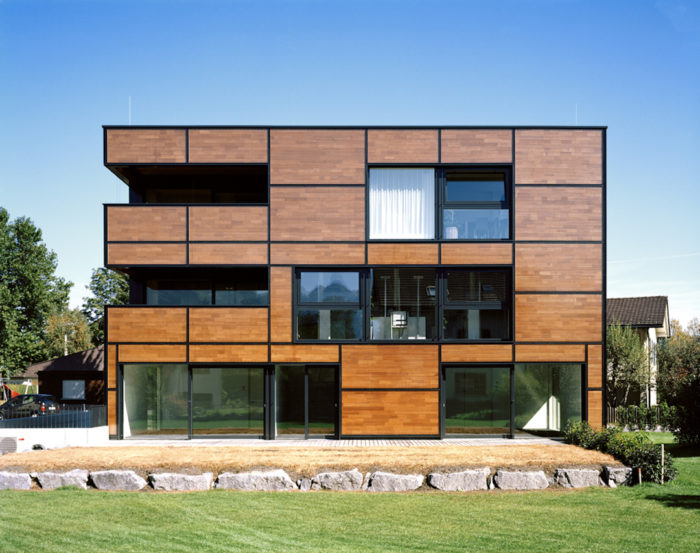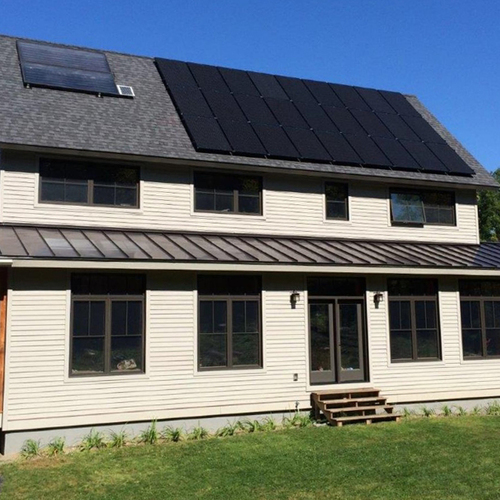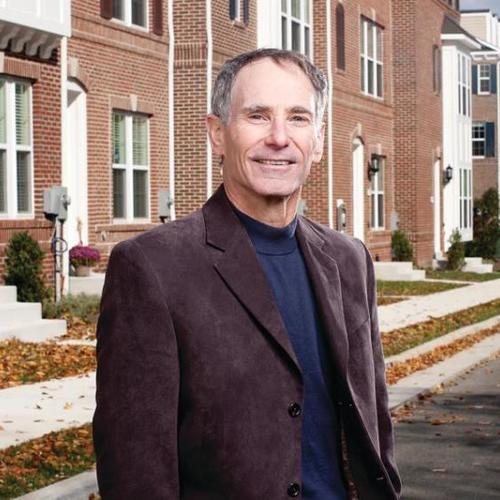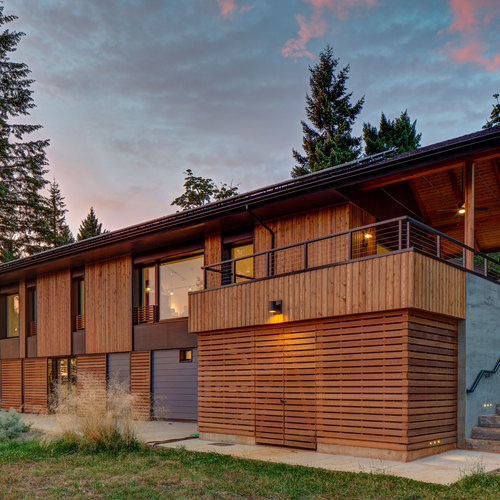Image Credit: Nelson Architect
Image Credit: Nelson Architect The angle of the fins in the wood absorber help determine how much solar energy the wood layer can absorb. In winter, a low sun angle allows light to reach the core of the wood; in summer, the angled louvers block direct sun. The SAF forms the outer, non-structural layer of the wall. Thermal performance varies under different conditions, according to its developers. The wood absorber is typically made from pine or larch. SAF can be combined with photovoltaic modules. In this building exterior, the lower wall is finished with a SAF while the upper part of the wall incorporates solar modules.
Eric Nelson, an architect with ties to both the U.S. and Switzerland, is looking for someone in North America willing to take a leap of faith with his novel insulation and cladding system. So far, there are no takers.
Nelson’s Solar Activated Façade (SAF) was recently named one of the greatest home innovations of the year by Popular Science magazine, but it’s a good bet that few builders or designers have ever heard of it, much less specified it for a new house. Developed in Switzerland in the late 1990s by an architect named Guiseppe Fent, SAF combines wood, glass and an air space in a wall assembly.
According to Nelson, a south-facing SAF that is just 9 1/2 inches thick will have an average “effective” R-value of 120 to 150 over the course of a heating season when installed on a wood-framed house in Boston, Massachusetts.
But Nelson’s use of the phrase “effective R-value” on his company’s website will raise red flags for many energy experts. “Effective R-value” is a metric with no scientific definition, and it has been associated with exaggerated claims in the past. Measured according to the way R-values must be reported in the U.S., the wall with an “effective R-value” of 150 would have a whole-wall R-value of about R-21. (For a discussion of questionable uses of the phrase “effective R-value,” see All About Thermal Mass.)
In the Boston example, the touted thermal performance wouldn’t be as eye-popping on walls facing a direction other than south, but according to Nelson, it would still be higher than anything builders can currently get their hands on. Nelson says that SAF has been “repeatedly tested” at Empa Switzerland (Swiss Federal Laboratories for Materials Science and Technology) and other labs.
In addition to its high “effective R-values,” the cladding needs little maintenance because it’s made mostly from glass, and the assembly should last 50 years or more. Nelson says those factors, combined with the energy it saves, give SAF a lower lifetime cost than a conventional exterior thermal insulation composite systems, also known as ETICS. (The cladding system known in Europe as ETICS is known in the U.S. as “exterior insulation and finish system,” or EIFS).
There are just two problems: it’s expensive, and Nelson has yet to find a customer on this side of the Atlantic willing to give it a try.
How the wall assembly works
The SAF is applied over a structural wall in new construction — a framed wood wall or a wall made of concrete block, for example — or over an existing wall when it’s used in an energy retrofit. It consists of a milled wooden louver called the “absorber,” an air gap, and a sheet of tempered glass, which together makes a layer 2 1/2 inches thick.
The fins are milled into the wood layer at an angle, which regulates how much solar energy the wood can absorb. In winter, when the angle of the sun is low, sunlight can reach the core of the absorber to heat it up during the day. After sunset, the solar-heated buffer cools down, releasing the heat it stored during the day and reducing heat loss through the wall. In summer, when the sun angle is higher, the glass reflects some of the solar energy; the layer of air behind the glass warms and rises, carrying heat up and out of the building while the downward angle of the louvers prevents sunlight from reaching the core of the wood layer (see Image #2, below).
The wall can be installed either as preassembled units or on site, Nelson says, although the preferred method now is to prefabricate panels off site.
According to Nelson, a major advantage of the assembly is that it produces very high “effective R-values” with minimal wall thickness. One example posted at his web site shows a framed 2×6 wall filled with rock wool insulation, 3/4-inch wood sheathing, and 1/2-inch gypsum drywall, clad with a SAF: the total wall thickness is 9 1/4 inches.
On a south-facing wall, the R-value would have an “effective R-value” of 150. On east and west walls, the “effective R-value” averages 95, and on the north wall the average over a heating season is 44. Thermal performance changes as conditions change.
“Our numbers are dynamic,” Nelson said in a telephone interview. “It’s a dynamic R-value. It’s actually different from hour to hour, day to day, month to month. For simplicity reasons we average. Throughout the winter period, we can produce an average [‘effective’] R-value of 150. Sometimes we may be at R-80, sometimes at R-120, sometimes at R-200.”
How the numbers were derived
The tests, carried out under contract at Empa Switzerland, measured heat flow through a sample wall section over a month-long period simulating winter, and a two-week span simulating summer conditions. Sensors to measure heat were placed throughout the cross section, beginning outside the glass to measure outside air temperatures and spaced at intervals to the interior surface.
A second purpose for the testing was to check whether the company’s computer software could accurately predict measured performance. Nelson described the tests in general terms, but said the reports themselves are proprietary.
“We can predict the U-values/R-values for any climate and for any orientation of the façade,” he said.
Are the “effective R-values” too good to be believed?
“Actually, it is just as you say,” Nelson said. “Those are mind-boggling numbers and it’s hard to wrap your mind around it. It doesn’t help me at times because it just creates too much doubt.
“I’ve had a lot of interested people, and they’re all amazed,” he continued. “They say, ‘Wow, this is absolutely gorgeous, and high performance,’ and everything but just trying to nail that first project is not all that easy. I saw this in Switzerland, too. You can be the subject of a lot of talk, but people are unsure about it because they are not used to thinking that way. You just stick with what you know — architects as well as clients…This is difficult, I think, because people just don’t understand it.”
[GBA contacted both the Oak Ridge National Laboratory and the National Renewable Energy Laboratory to ask whether any scientists there might comment on the SAF assembly. NREL said no one on its staff was familiar with the technology; ORNL has yet to respond.]
Plan on high cost
Nelson said a SAF would cost up to twice as much as an Exterior Thermal Insulation Composite System (ETICS), although he wouldn’t say exactly how much. In a life-cycle cost analysis conducted in Switzerland, and assuming the wall lasted for 50 years, he said the cost would actually be one-third lower than ETICS when energy savings and the cost of disposal were figured in.
“One main advantage is you can have much thinner walls to achieve high performance, so you can reduce the thickness of your walls tremendously,” Nelson said.
Where square footage is valuable and setbacks are very tight, he added, getting high performance without sacrificing too much floor area could outweigh higher initial costs, he said, although that probably would not be the case in rural areas where property prices and housing densities are lower.
Nelson says that the assembly has included textured solar glass to increase the amount of solar energy that passes through to the wood louver, but he’s weighing a switch to tempered float glass because it’s less expensive. Performance “barely changes” with the substitution.
Another incentive could be the addition of photovoltaic cells in the assembly, a feature Nelson says is the subject of a patent application.
Still looking for his first customer
Nelson said he grew up in Switzerland but eventually moved to Florida, where he earned a master’s degree in marine science. He worked for the U.S. Geologic Survey, then switched gears and earned a master’s degree in architecture.
“I quickly realized that architecture, green building, at the time was so backward, especially in Florida, of course,” Nelson said. “I decided to go back to Switzerland where I ran into [Guiseppe Fent] by total coincidence. I thought he would be a provincial architect. It turned out to be he was quite an innovative, thinking-out-of-the-box kind of person.”
Fent, Nelson said, had developed SAF in the 1990s. It was installed on the first house in 1999 and has since been used on 100 or so projects around Switzerland, sold through Fent’s Lucido Solar company.
Nelson called Fent a “self-made, innovative man who has pushed the envelope in green building.”
“He’s been a true pioneer when it came to green buildings,” Nelson said. “The reason why he developed this system was because he just couldn’t find any suitable materials that were really green and suited his ambitions. So he created this and became his own best client.”
Nelson went to work for Fent’s company. Eventually, Fent approach Nelson and offered him rights to the SAF patent in North America. Since then, Nelson has been building a network of contacts, many of them in the Boston area, while he tries to drum up business. He was close to landing a job in Tennessee, and has been talking with a Minneapolis architect who’s apparently interested in using SAF on his own house. But so far, SAF is a product in search of its first North American customer.
“I’ve been kind of stirring the pot, building my website, building my business plan, market research and all that, step by step,” Nelson said. “We have been close to projects…”
Weekly Newsletter
Get building science and energy efficiency advice, plus special offers, in your inbox.
















8 Comments
Install on his own home?
Wonder why he doesn't install on his own home if it is so good?
Then he would have a product to demonstrate...
Let's call this what it is...
This is a panelized Trombe wall. Best application: locations with large diurnal temperature swings.
With no testing data and methodology to present, then this is just your latest green-washing product. If the technology is so fabulous, then I do not see why there would be any problems sharing the testing procedures and resulting data.
Magic air
Another magic air system. Like the foil bubble wrap.
3" of wood and glass will add R-24 on the North wall and R-75 on a South wall. I'll believe it when I see a house with actual energy data compared to an energy model.
super insulated shed
As a consumer and do it yourselfer, is there a reason a person with an idea like this would not build a 300 square foot shed near the Canadian border to test this in real life?
Reponse to previous comments
Dear all,
Thank you for taking the time to read this article. In response to your questions, we are a small start-up that is currently looking for seed/series A money as well as (industrial) partners to do exactly what you suggest, putting a proof of concept on the ground even though the system is fully vetted with over a hundred completed, small and large scale buildings in Switzerland and surrounding countries and could be installed today in North America. I personally do not own a home that I can put up for such a case study. The architect who invented it, however, does own such a home.
Furthermore, the system has been tested on the stand by reputable testing labs in Switzerland and Germany and verified in numerous case study. The R-values that are calculated with a proprietary software have been verified and accepted by the SIA , the Swiss counterpart to the AIA, to be entered into certified energy models similar to ASHRAE90.1. For our personal protection, we do not release test results that may give away the algorithm to our software that could give away our competitive edge, which is primarily understanding and predicting the heat flow within.
Alas, the discussion on "effective" or "dynamic" R-Values is not an easy one, which has properly been eluded to for the lack of a proper definition. In terms of being able to communicate, we do assert to such terminology and can substantiate when needed. Keep in mind SAF is closely related to the family of TIMs (Transparent Thermal Insulations), hence it is not just a simple matter of figuring out the R-value, since it actually also hold G-Value parameter. However, this discussion has to be done among engineers.
So, where do we stand? We have a great "proven" (in Switzerland, also known for its quality) product that we would like to introduce to the North American market for which we are looking for early adapters and investing partners that will give us the resources to take a Swiss product, translate (standards, units and language) and adapt it to the US market, re-test what needs to be re-tested and provide all the due diligence necessary to gain the confidence of the clients.
We welcome any constructive leads (criticism included) that will make this a better experience for everyone. If you want to remain open-minded and require more information or a case study on US soil, please contact us personally and we will do my best to provide you with such information as it becomes available (in English).
Eric Nelson
Nelson Architech GmbH
(Owner of SAF North America)
PS. I believe the link to our product site was not good, but should be corrected anytime now.
Response to Eric Nelson
Eric,
Thanks for your comments. As you probably know, ASTM has established test procedures for measuring the R-value of materials, as well as test procedures for measuring the R-value of assemblies.
In the U.S., federal law (the R-value Rule) lists the ASTM test procedures that must be used to measure R-value. It is a violation of law in the U.S. to provide information to consumers that lists R-values that aren't measured by these listed ASTM test procedures. Anyone marketing insulation materials to consumers must abide by this law.
The "effective R-values" discussed on your web site were not measured according to these ASTM methods, since the ASTM methods do not take solar heat gain into account. When your web site shortens the phrase "effective R-value" -- a phrase with no defined meaning -- into the shorter phrase "R-value," it appears to me that your claims are a violation of the federal R-value rule.
Needless to say, if you are going to invent a new metric that takes solar heat gain into account when measuring R-value -- let's call this new metric the "Nelson value" -- then you can't compare it to the R-value of an ordinary wall assembly. If you measure the performance of an ordinary wall assembly in a way that takes solar heat gain into account, you will find that any ordinary wall will lose less heat in winter when the sun warms the siding. What's good for the goose is good for the gander. If you want to use the Nelson value to measure your wall, you have to let me use the Nelson value to measure my wall, too.
Thermal Material...
Maybe I'm missing something, but why would you use wood for a thermal absorber, when there are other materials that would absorb and transfer heat more effectively? Wouldn't cement board be a better material? Not sure how best to form the louver effect in cement board, but I would think there is a better material for this.
Panel seams? Longevity?
GBA has demonstrated many times that the relentless pursuit of super-high R-values at any cost is hard to justify either financially or environmentally. But apart from the 'effective R-value' claims the weakest link in any panelized wall cladding system is at the horizontal seams, particularly one in which you can expect high rates of expansion and contraction in the face veneer. I see no indication of attention to these critical details where water and air penetration at these vulnerable abutments could soon obliterate any conceivable energy conservation benefits. And just a fifty year (predicted) life for a high end enclosure system? I've seen crappy masonite siding last longer than that. Not a comforting thought from a long-term green building perspective.
Log in or create an account to post a comment.
Sign up Log in